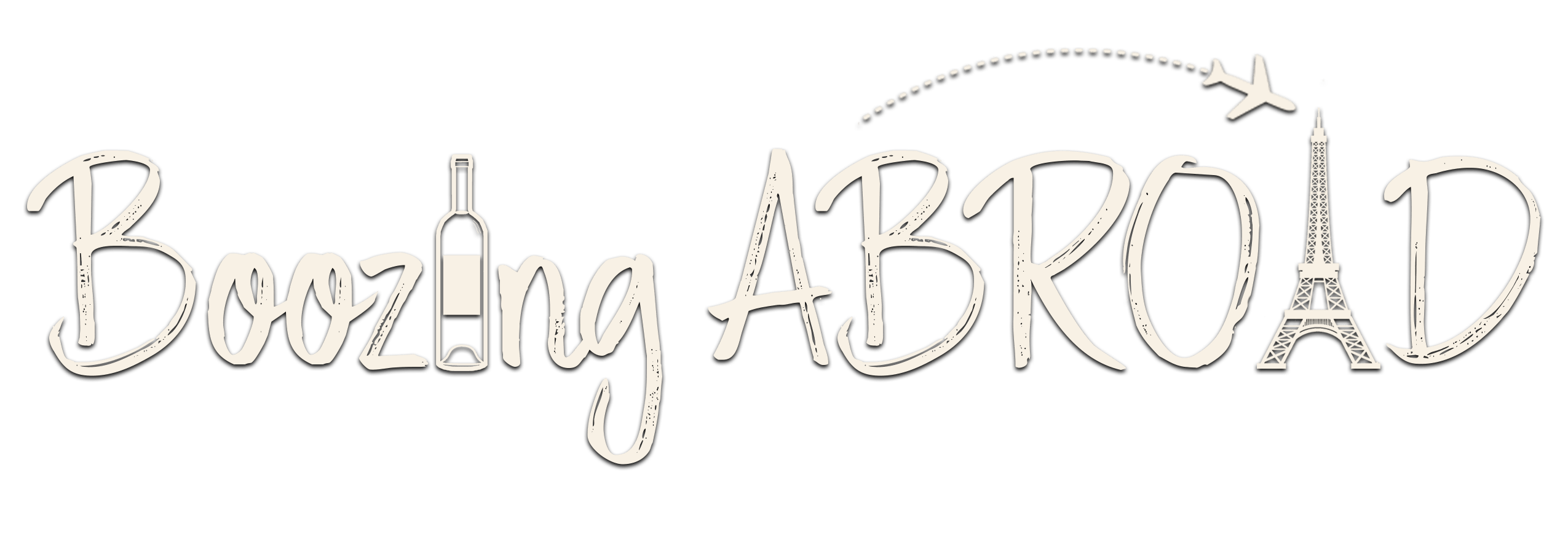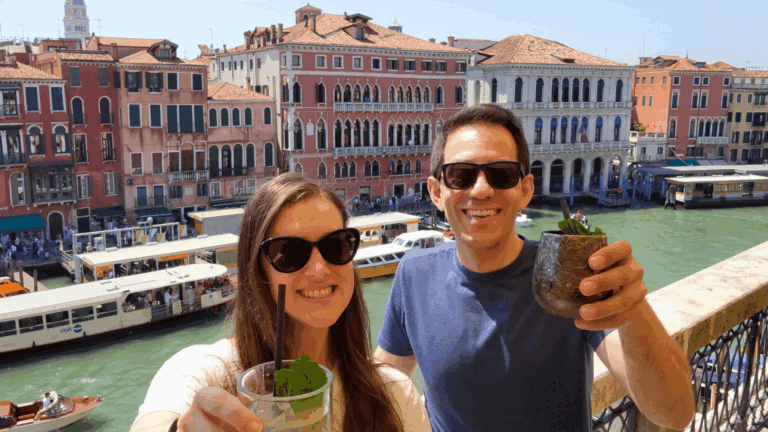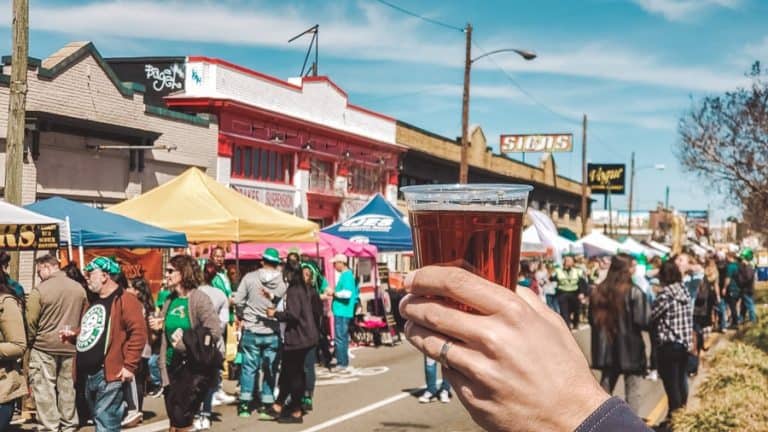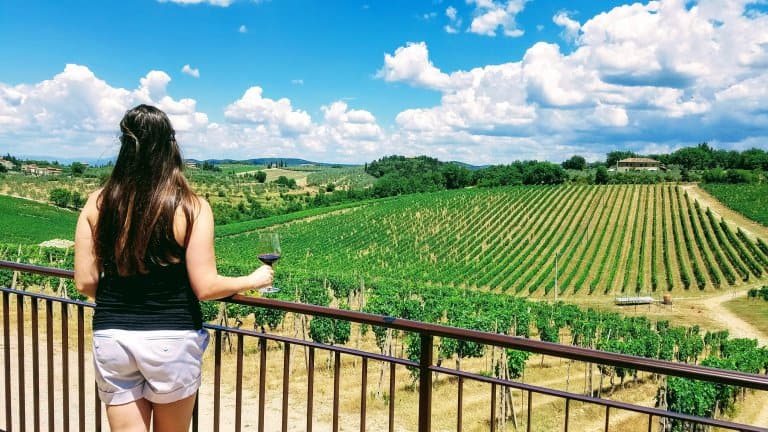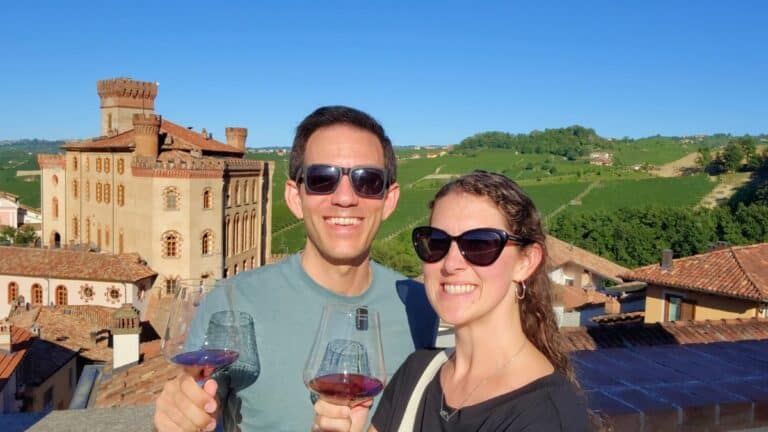Top Things to Do in One Day in Bologna, Italy
Spending one day in Bologna, Italy, offers a perfect taste of this city’s irresistible charm, rich history, and world-renowned cuisine.
Known as the food capital of Italy, Bologna is brimming with unforgettable flavors, from hearty pasta dishes to iconic local delicacies.
Beyond the food, the city captivates visitors with its stunning medieval architecture, including one of the world’s largest (and still unfinished) churches.
As locals who have called Bologna home for months, we’ve crafted a one-day itinerary that highlights the very best of what this incredible destination has to offer—no matter the season.
Short on Time? Here are the key takeaways:
- One day in Bologna is plenty of time to see the major attractions
- Most of the attractions are free to view or under €20 per person
- In our opinion, don’t miss visiting Madonna di San Luca and the Archaeological Site at the library
- While you are here, make sure you try to eat mortadella and some tortellini!
Boozing Abroad contains affiliate links throughout the site. If you choose to purchase items through these links, we will earn a small commission at NO extra cost to you. Read the full disclosure policy here**
What is Bologna Italy known for?
Bologna is often described by three nicknames: La Rossa, La Grassa, and La Dotta – or for those whose Italian isn’t that great…the Red, the Fat, and the Learned. Each one of these nicknames tells a story about what makes this city so unique.
- La Rossa, or The Red, refers to the color of the buildings and rooftops that give Bologna its warm, distinctive color, and some even say it represents its historical connection to progressive political thinking.
- La Grassa, or The Fat, celebrates Bologna’s reputation as the culinary capital of Italy – from rich ragù to fresh tortellini.
- And finally, La Dotta, or The Learned, reflects its status as home to the University of Bologna, the oldest university in continuous operation in the world, founded all the way back in 1088!
Bologna’s history is just as rich as its culture. This city dates back to at least the 6th century BC, when it was an important settlement for the Etruscans.
It later became a Roman colony in 189 BC, known as Bononia. Over the centuries, Bologna flourished as a key center for trade, education, and art, and it remains one of Italy’s most vibrant cities today.
Is Bologna Italy worth visiting?
Absolutely! It’s a great day trip from Florence, Milan or Venice with plenty of things to see and eat! One day in Bologna will allow you to see all the major attractions, but we’d recommend at least 2 so you can try all the sensational foods!
We moved to Bologna because we fell in love with it’s charm, food, history and walkability.
Watch the Adventure on YouTube
If you want to see everything in action, we did this entire article as a video as well! Click on the video below to watch!
One day in Bologna, Italy Map
Click on the interactive map below!
How to Use This Map:
- Click the tab in the top left corner to view the layers and see names.
- Check or uncheck boxes to show or hide certain categories.
- Click any icon on the map for more details about that spot.
How to Save This Map: To view later, open Google Maps, go to Your Places → Maps, and find it under your saved maps. Tap the ⭐️ star icon next to the map name to save it to your Google account.
Piazza Maggiore
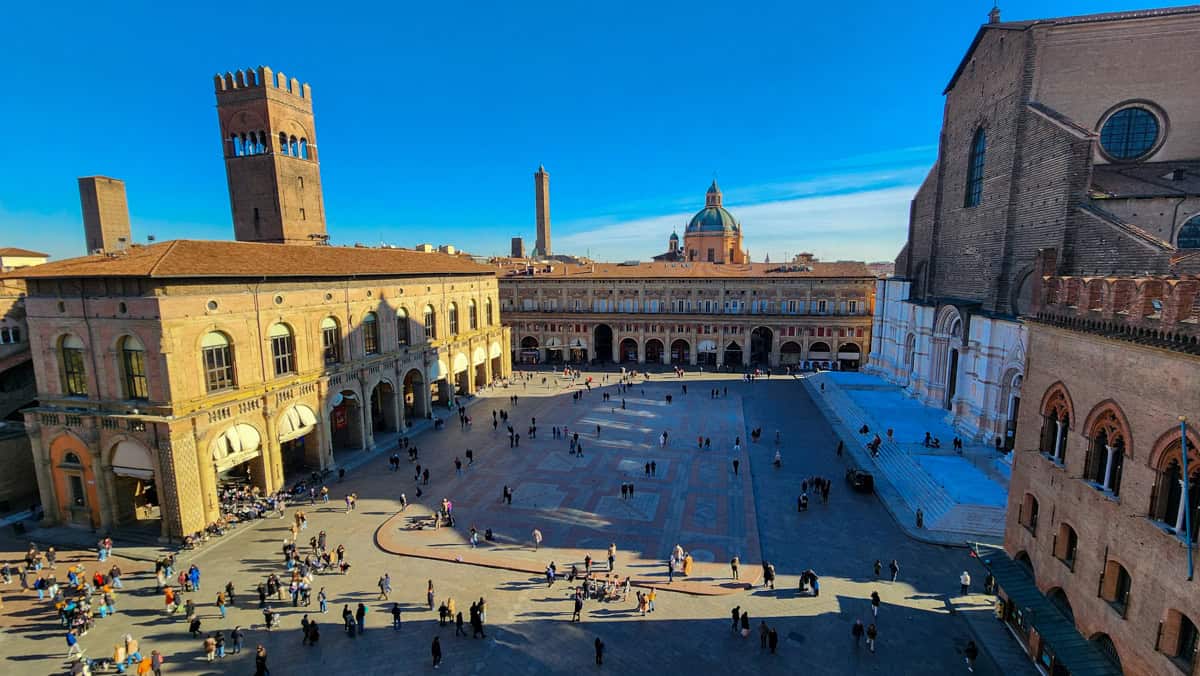
- Cost: Free
- Hours: 24/7; 365 days
Start your one day in Bologna at Piazza Maggiore: the beating heart of Bologna. This square has been the city’s center of political and social life since the 13th century.
It’s surrounded by historic buildings like the Palazzo d’Accursio and the Basilica di San Petronio.
The square is bustling with street performers, outdoor cafés, and plenty of spots to sit and admire the architecture. It’s also the perfect starting point for exploring the surrounding landmarks.
The Two Towers (Le Due Torri)

- Cost: Free to view from the streets but can’t go inside
- Hours: 24/7; 365 days
Bologna’s most iconic landmarks – the Two Towers, Le Due Torri.
They tell the story of the city’s medieval past. Built in the 12th century, these towers were part of a trend among Bologna’s noble families to construct tall structures as both a show of wealth and a defensive strategy. At one point, Bologna was believed to have had over 100 towers dotting its skyline, earning it the nickname the ‘City of Towers.’
The Asinelli Tower, the taller of the two, stands at about 97 meters high (318 feet) and was completed around 1119. And fun fact, it’s the tallest leaning medieval tower in the world.
Clocking in at about 48 meters tall (157 feet) today, the Garisenda Tower is about half the size of its big brother Asinelli. But it initially stood about 60 meters tall (196 feet) before being lowered in the 14th century due to instability in the ground which has left it leaning rather dramatically.
The tower is leaning so badly and at such risk of collapse that in late 2023, the city of Bologna actually began constructing a barrier to contain debris if and when it does fall.
So, unfortunately, for the foreseeable future, we can only get so close to these towers as work continues to try to prevent a collapse, but they are a must see when you are spending one day in Bologna.
The Quadrilatero
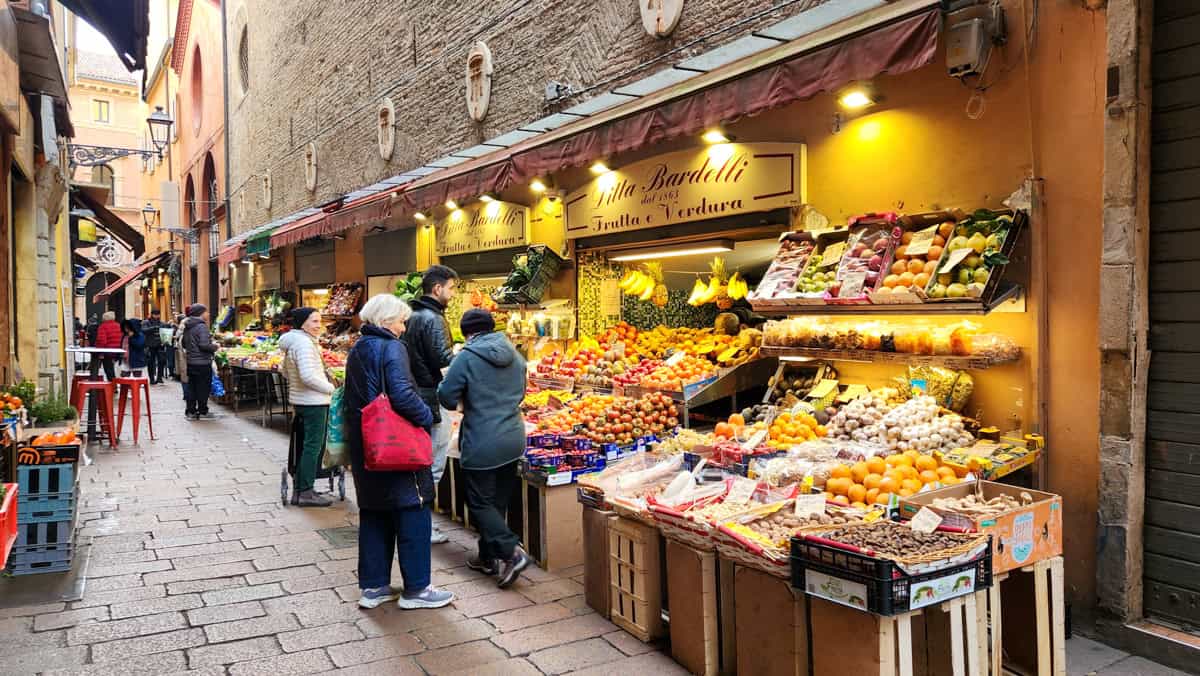
- Cost: Free to walk around; additional cost if you buy something
- Hours: streets are always open, but the markets/restaurant times vary
The Quadrilatero is one of Bologna’s oldest and most vibrant districts, a maze of narrow medieval streets filled with food markets, specialty shops, and lively restaurants.
Located just off Piazza Maggiore, this area has been the heart of Bologna’s commercial and gastronomic life for centuries.
The Quadrilatero’s roots trace back to Roman times, but, as you might have guessed, its name comes from its quadrilateral shape, defined by the streets Via Rizzoli, Via Castiglione, Via Farini, and Piazza della Mercanzia.
During the Middle Ages, it became a bustling hub for artisans, merchants, and tradespeople.
The architecture and layout of the district reflect its medieval origins, with its narrow streets and historic shopfronts.
The Quadrilatero is a must-visit for anyone exploring Bologna in one day, especially food and history enthusiasts. Here’s what makes it so special:
- Gastronomic Paradise:
- The Quadrilatero is home to some of Bologna’s best food markets and specialty shops. You’ll find artisanal pasta makers, fresh produce, local cheeses like Parmigiano Reggiano, and cured meats such as Mortadella.
- Popular stops include Tamburini for deli delights and Salumeria Simoni for meat boards and local wine.
- Historic Atmosphere:
- Walking through the Quadrilatero is like stepping back in time. The cobblestone streets, medieval porticos, and ancient signage evoke centuries of commerce and culture.
- Osteria del Sole – the oldest bar in Bologna (more info below under “best bars”)
- Lively Ambiance:
- The area buzzes with life as locals shop for daily ingredients, sip espresso at outdoor cafes, or share aperitivi at quaint bars.
- Dining and Drinks:
- Enjoy traditional Bolognese dishes at nearby trattorias or have a quick snack of tigelle or crescentine filled with meats and cheeses. Pair your food with a glass of Lambrusco or Pignoletto.
Basilica di San Petronio
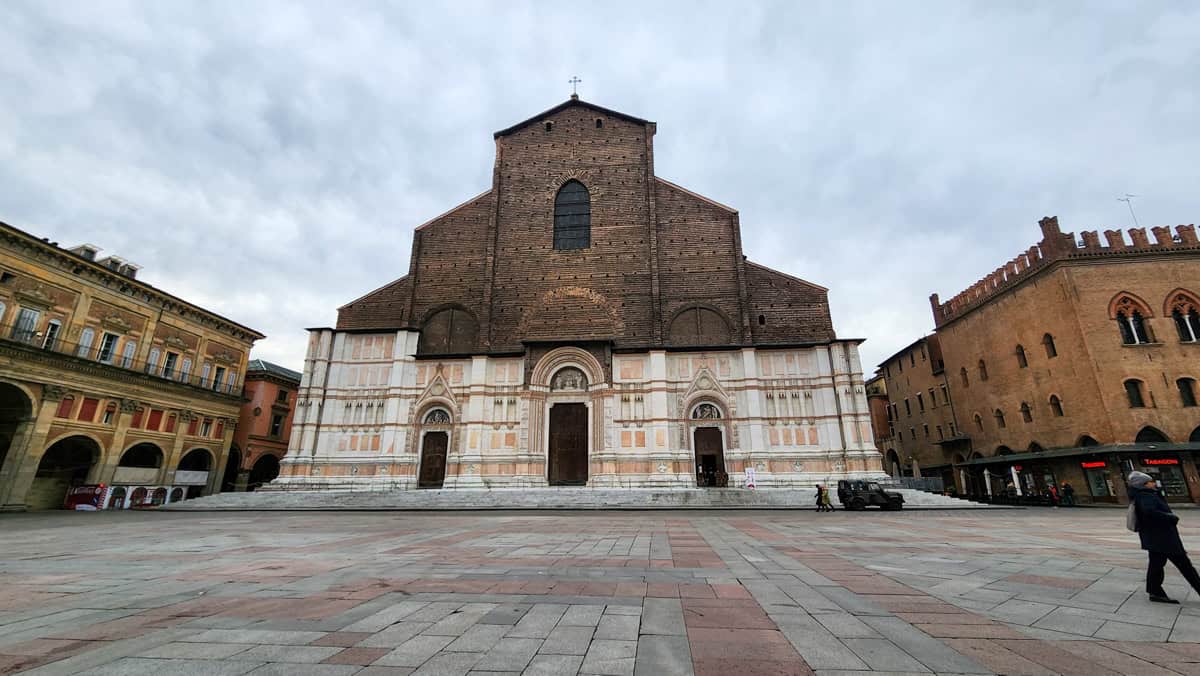
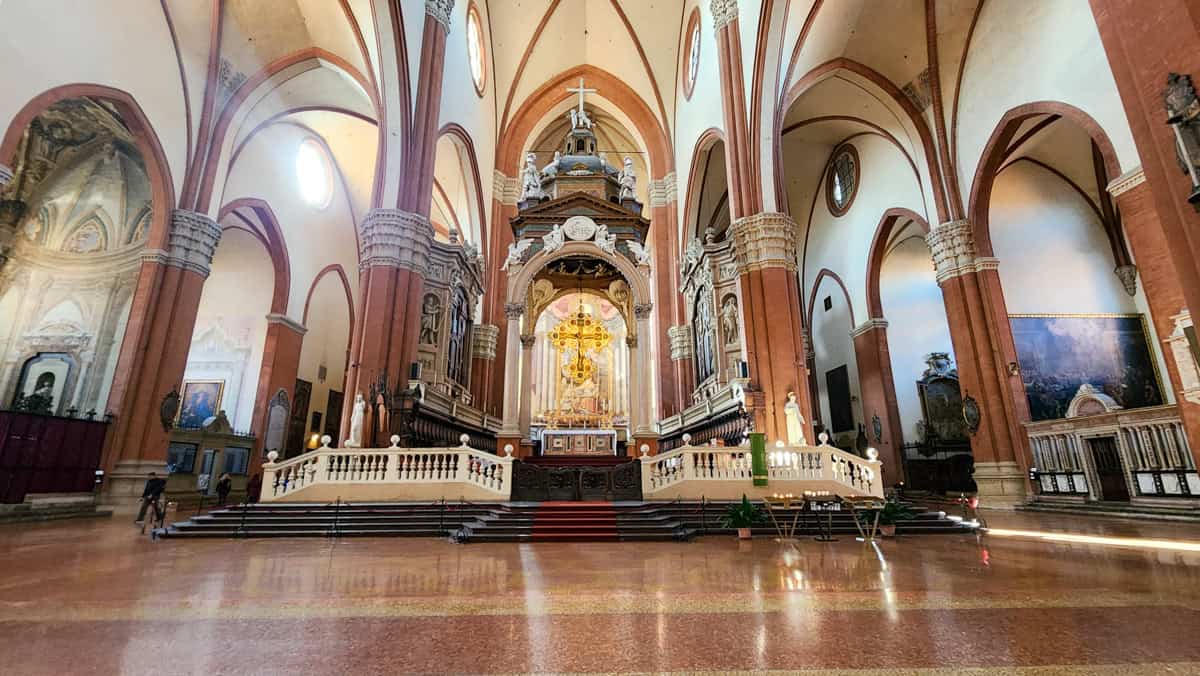
- Cost: Free
- Hours: Daily 8:30 AM – 1:00 PM and 2:30 PM – 6:00 PM
The Basilica di San Petronio is not only the largest church in Bologna but it was originally intended to be the largest church in the world. Construction began in 1390, and its ambitious design was meant to surpass the St. Peter’s Basilica in Rome.
However, those plans changed when the Vatican caught wind of this and intervened, reportedly concerned about Bologna overshadowing Rome.
As a result, the basilica remains unfinished to this day, with its facade showing a striking contrast between the ornate lower section and the bare brickwork above it.
Inside, the basilica is no less impressive. It stretches over 132 meters (433 feet) in length and 66 meters (216 feet) in width, making it the 10th largest church in the world by volume.
One of its highlights is the meridian line, a massive sundial that runs along the floor, designed by astronomer Giovanni Cassini in the 17th century.
We’ve been living in Bologna since June 2024 and haven’t seen the sundial working (yet). If you are lucky enough to experience it, please let us know in the comments!
Dress code for entering the church:
- Both men and women should ensure their shoulders and knees are covered, so avoid wearing tank tops, short skirts, sheer dresses, or low-cut tops
- Inside the Basilica, hats or caps must be removed before entering
- Suitcases and luggage are not allowed
- No phone calls or video calls allowed
- Food, drinks, glass bottles and pets are not permitted
During the summer months, you can rent clothing items to enter the church, but we’d use caution before renting them as we don’t know how frequently it gets washed.
Torre dell’Orologio (Clock Tower)
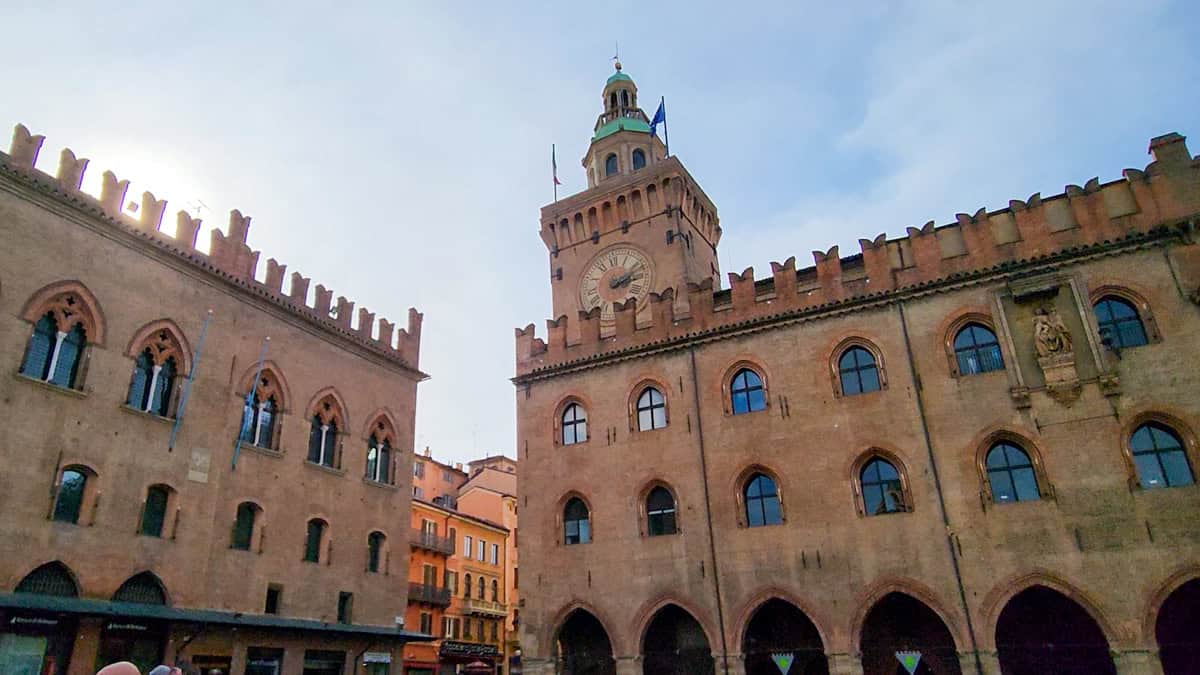
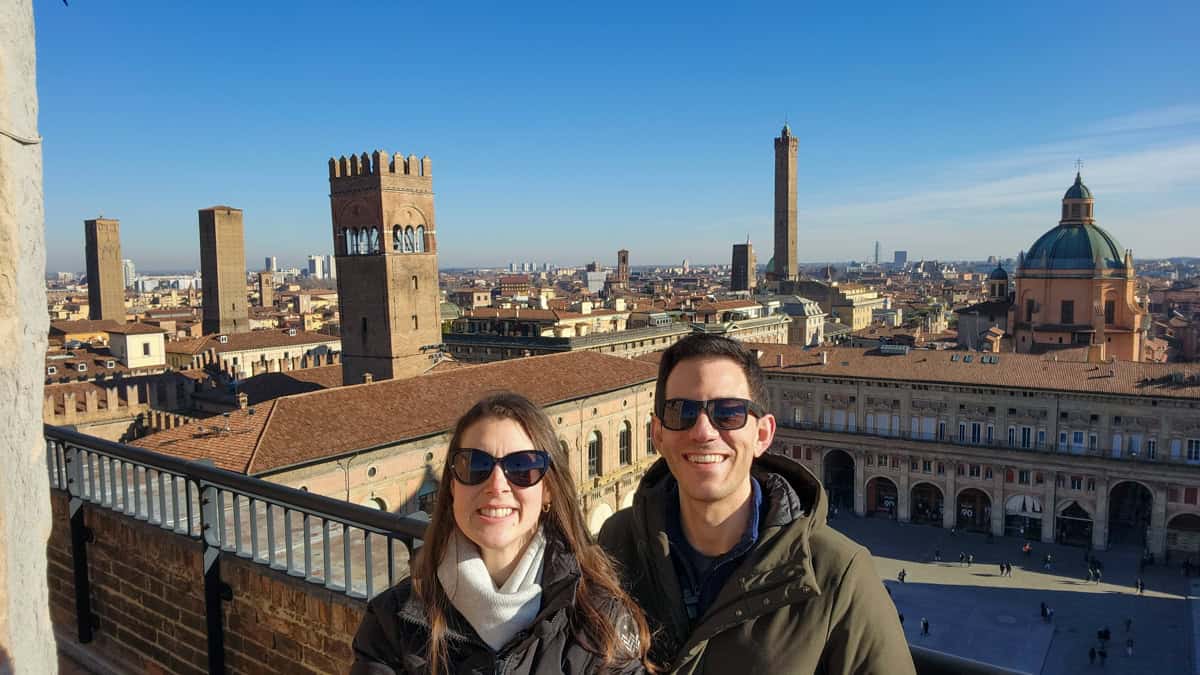
- Cost: €10
- Hours: Daily from 10 AM
- Closing time varies based on time of year. Click here to check current hours
The Torre dell’Orologio, or the Clock Tower, is part of Palazzo d’Accursio. Built in the 13th century, the tower once served as a symbol of the city’s wealth and power.
The clock, which dates back to the 16th century, is a remarkable piece of engineering, featuring intricate astronomical details and still keeping accurate time.
The tower offers panoramic views of Piazza Maggiore and beyond. It’s a great spot for photos and a chance to see the inner workings of the historic clock.
Important things to know before you visit:
- Reservations are REQUIRED
- Access to the summit terrace is gained via a narrow staircase after signing a waiver on site. Access is prohibited for children under 8 years of age, even if accompanied by an adult
- Animals: animals of any size are prohibited
- Bulky bags and backpacks aren’t permitted
- Footwear: visitors must use closed shoes or sandals with back straps. It is forbidden to enter wearing flip-flops, high-heeled or loose-heeled shoes or barefoot
Archaeological Site at Biblioteca Salaborsa
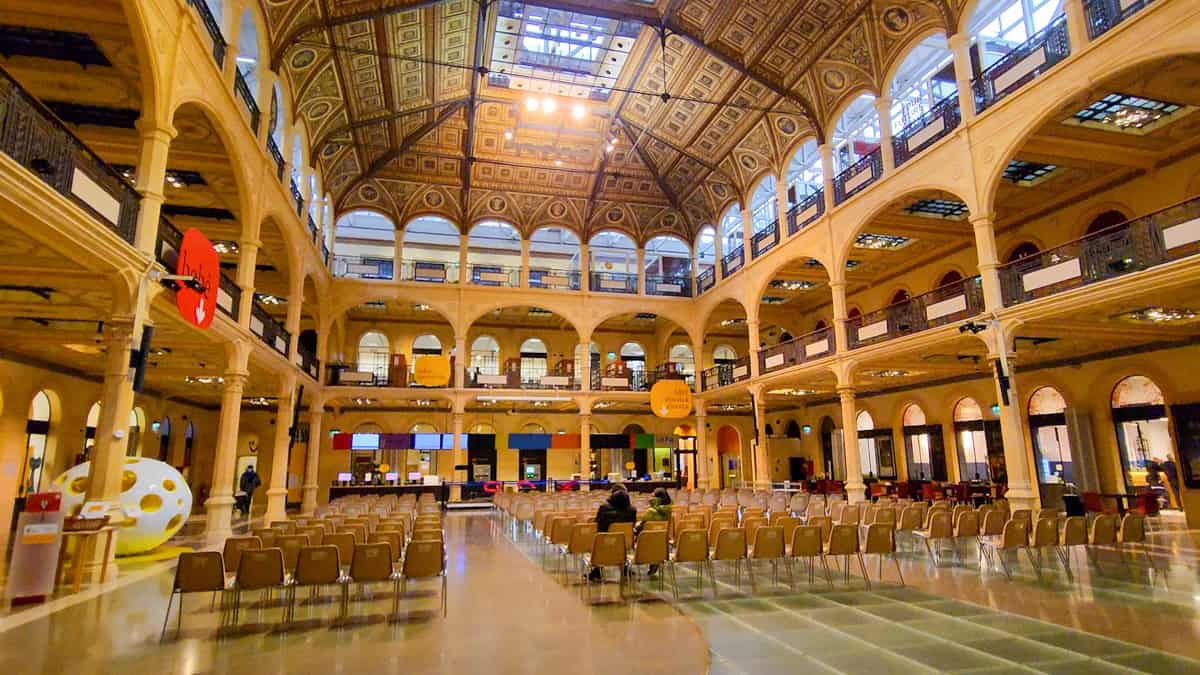
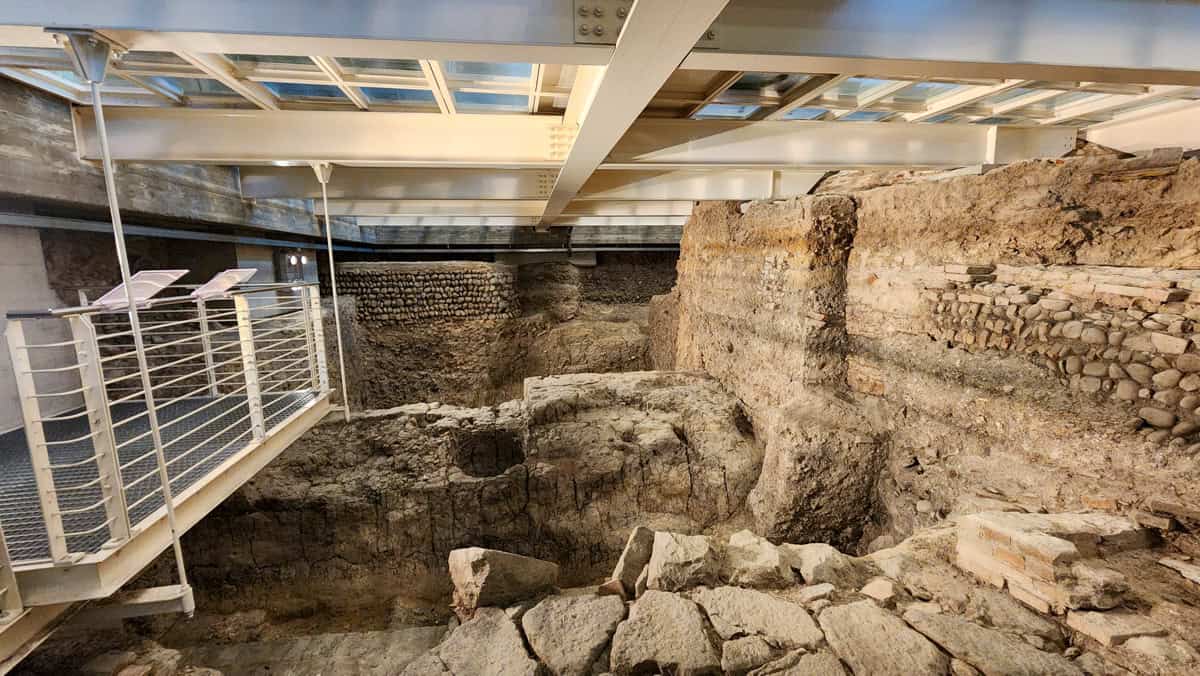
- Cost: Free
- Hours:
- Monday: 2 PM – 8 PM
- Tuesday – Saturday: 9 AM – 8 PM
- Sunday: Closed
Bologna’s Biblioteca Salaborsa isn’t just a beautiful library – it’s also a window into the city’s ancient past.
Beneath its modern floors lie the remains of a settlement that dates back over 2,000 years.
The ruins include remnants of Etruscan structures from the 6th century BC and traces of wells and streets from the 2nd century BC.
Neptune’s Fountain (Fontana del Nettuno)
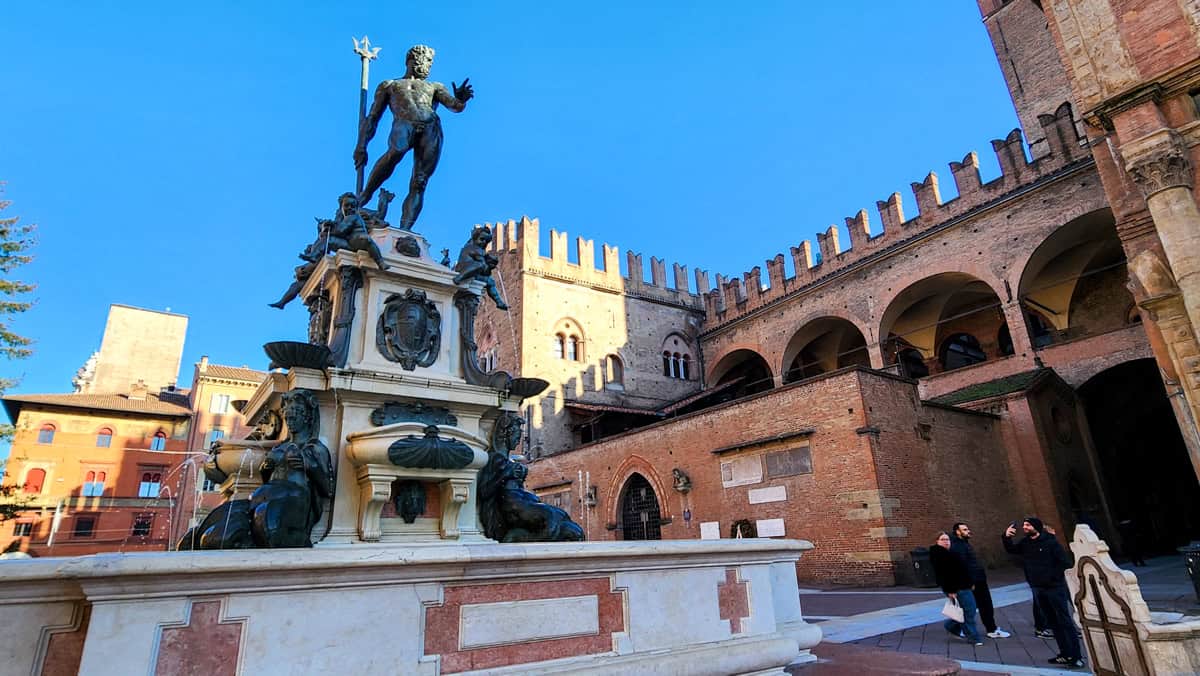
- Cost: Free
- Hours: 24/7; 365 days
Neptune’s Fountain, or Il Gigante, is a masterpiece of Renaissance sculpture, designed by Giambologna in the 16th century.
Look closely for the cheeky details, like the water spouts and the symbolic trident, which inspired the Maserati logo!
Basilica Santuario Santo Stefano (Complesso delle Sette Chiese)
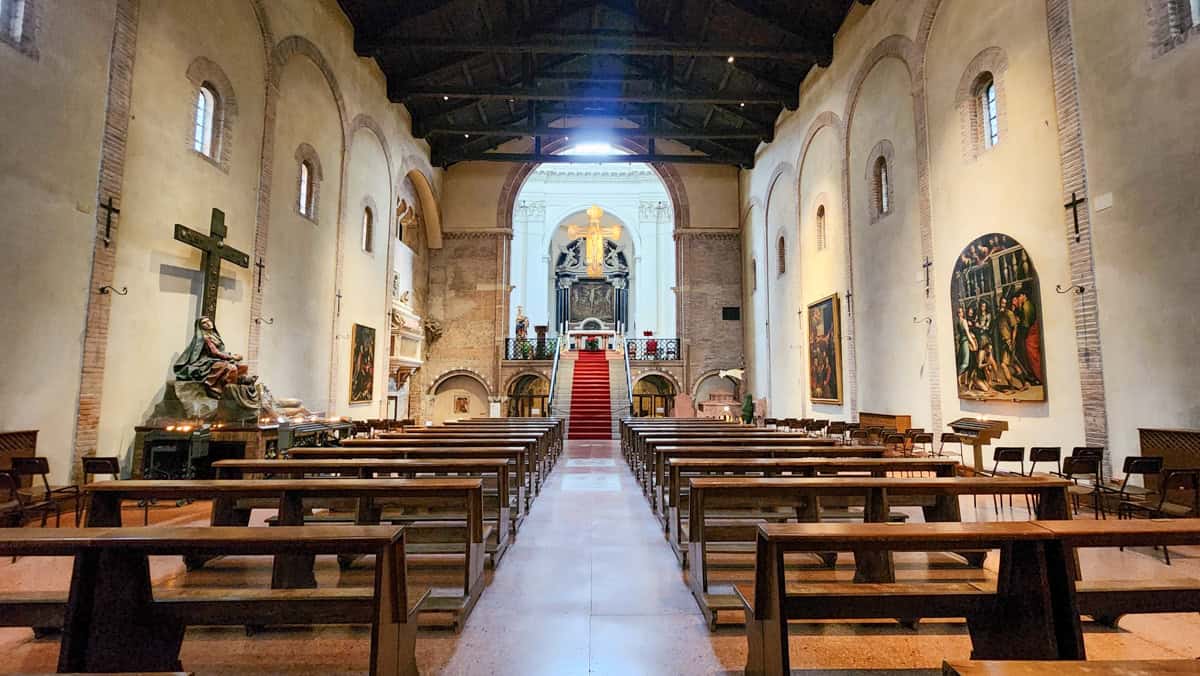
- Cost: Free
- Hours:
- Monday: 5 PM – 7:30 PM
- Tuesday – Sunday: 7:30 AM – 12:30 PM; 2:30 PM – 7:30 PM
The Basilica Santuario Santo Stefano, often referred to as the Seven Churches, is one of the most ancient and fascinating sites in Bologna. While only four of the original seven churches remain intact today, this complex still embodies centuries of history, faith, and architectural evolution.
The complex was built between the 5th and 12th centuries on the site of an ancient Roman temple dedicated to the Egyptian goddess Isis. Legend has it that Saint Petronius, the patron saint of Bologna, envisioned creating a structure that symbolized the Holy Sepulchre in Jerusalem, turning this site into one of the most sacred places in the city.
The Remaining Churches and Highlights:
- Church of the Crucifix (Chiesa del Crocifisso):
This is the first church you’ll encounter. Built in the 8th century, it houses relics of Saint Petronius and a beautifully carved wooden crucifix. - Church of the Holy Sepulchre (Chiesa del Santo Sepolcro):
At the heart of the complex, this circular structure is believed to have been built over the tomb of Saint Petronius. Its design mirrors the Holy Sepulchre in Jerusalem, with an austere yet sacred atmosphere. - Church of Saints Vitale and Agricola (Chiesa dei Santi Vitale e Agricola):
Dedicated to Bologna’s earliest martyrs, this church contains ancient Roman columns and early Christian artifacts. The tombs of Saints Vitale and Agricola are still here. - Cloisters and Courtyard:
The Benedictine cloisters are a peaceful retreat, with their elegant arches and columns offering a glimpse into monastic life during the Middle Ages.
Historical Fun Facts:
- One of the original seven churches, the Church of Saint John the Baptist, was destroyed over time, but its remnants can still be seen within the complex.
- The site contains some of the oldest religious architecture in Bologna, dating back to the Roman and early Christian periods.
Each church has its own distinct atmosphere, from the simplicity of the Holy Sepulchre to the intricate carvings in the cloisters. Don’t rush – this is a place to reflect and immerse yourself in history.
San Luca Express to Basilica di San Luca
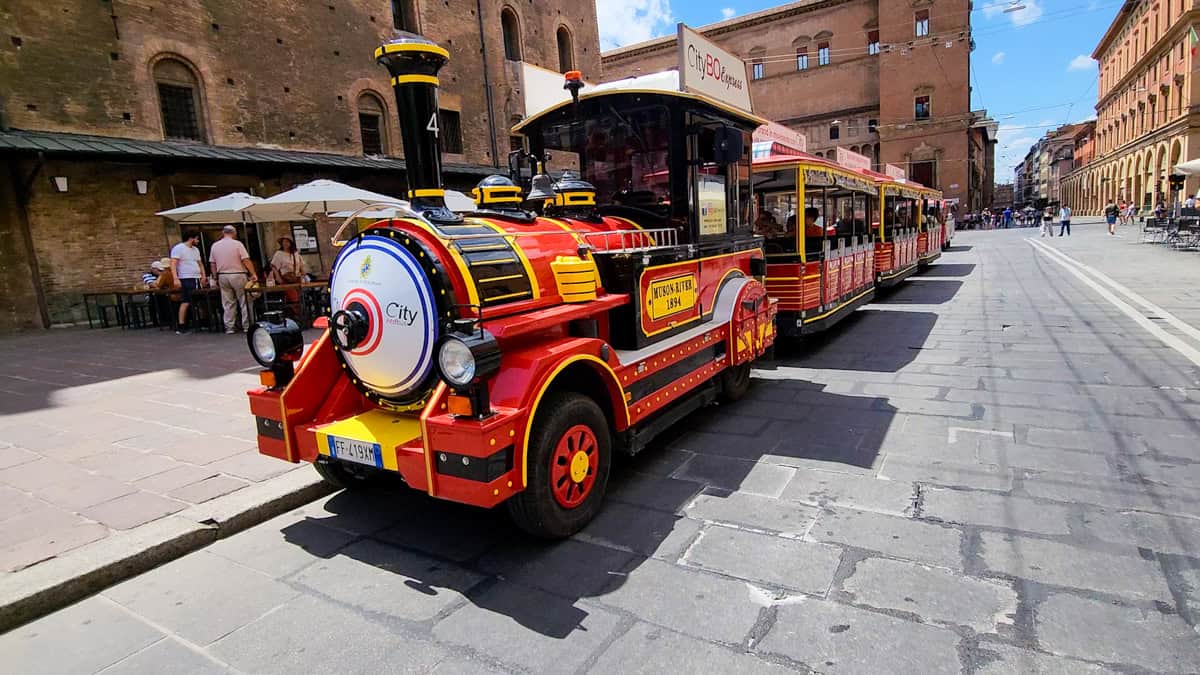
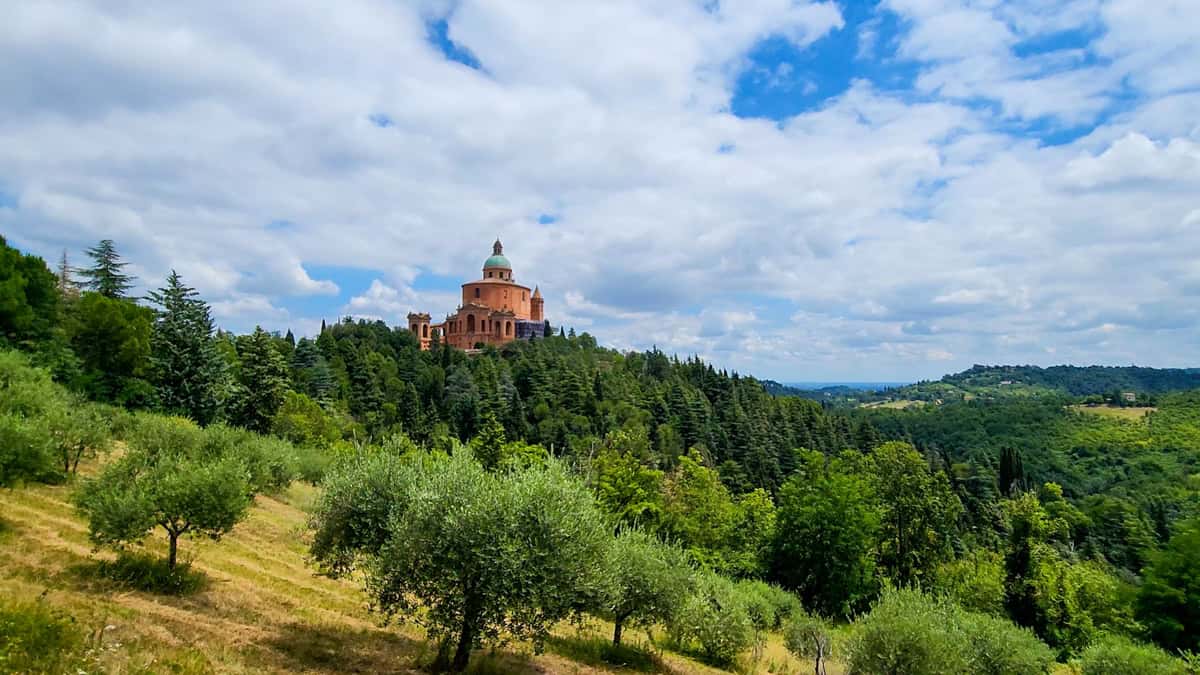
- Cost: €13
- Hours: Monday, Friday, Saturday and Sunday only
If you’re looking for a fun and convenient way to visit one of Bologna’s most iconic landmarks, the San Luca Express is a fantastic option. This bright red tourist train takes you on a scenic journey from the heart of the city to the Basilica di San Luca, which sits atop Colle della Guardia, overlooking Bologna.
The Basilica, which broke ground in the late 1100s and was completed almost 600 years later in 1765, is famous for its breathtaking views and the Portico di San Luca, the longest portico in the world. The portico spans nearly 4 kilometers (2.5 miles) with 666 arches, leading pilgrims from the city center to the church. The train offers a more relaxed way to ascend to the basilica without tackling the uphill walk.
History of San Luca and the Basilica:
The Basilica di San Luca houses the revered Madonna di San Luca, a Byzantine icon of the Virgin Mary believed to have been painted by Saint Luke himself. According to legend, the icon was brought to Bologna in the 12th century to protect the city. The basilica was later constructed to enshrine this miraculous image.
What to Expect:
The San Luca Express departs regularly from Piazza Maggiore and provides an informative audio guide in multiple languages as you ride through Bologna’s historic streets and up into the hills. The train drops you off near the basilica, where you can explore the church’s beautiful interiors, climb to the terrace for panoramic views of the Emilia-Romagna countryside, or take a leisurely stroll along the portico.
Best Time to Visit:
Morning trips are ideal for cooler temperatures and clear views from the basilica. Sunset rides are also stunning, as the warm light bathes Bologna’s red rooftops and rolling hills.
Practical Tips:
- Tickets can be purchased online or at the departure point in Piazza Maggiore
- The ride takes about 25 minutes each way, with time to explore the basilica before returning to the city
- If you’re feeling adventurous, you can take the train up and walk back down through the portico
Torre Prendiparte (Sundays only)
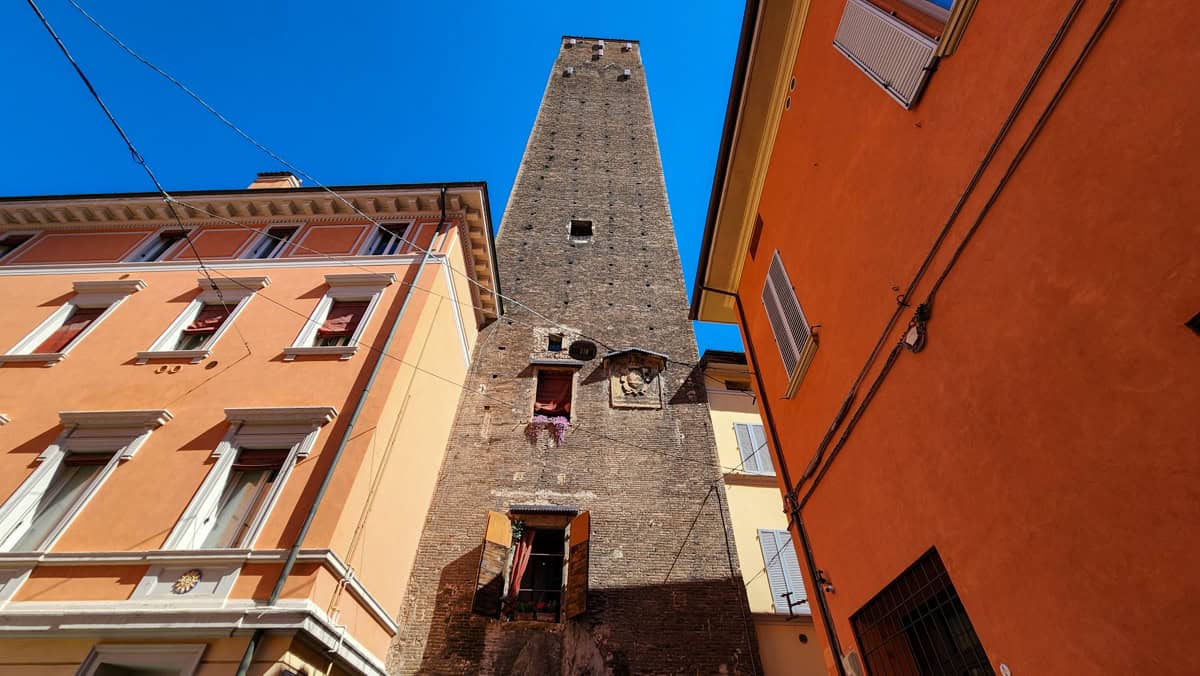
- Cost: €10 for adults / €8 for children
- Hours: 10 AM – 5 PM
Torre Prendiparte, also known as the Prendiparte Tower, is one of Bologna’s most fascinating historical structures and a hidden gem in the city’s skyline. Built in the 12th century, this 60-meter (197-foot) tall tower is one of the few remaining of Bologna’s original 100+ towers, which earned the city its medieval nickname, “La Turrita” (The Towered).
The Prendiparte Tower was originally constructed as a defensive structure by the powerful Prendiparte family during a period when noble families built such towers to demonstrate their wealth and influence. Later, during the 18th century, it was repurposed as part of the city’s ecclesiastical complex, serving as a shelter for clergy and even as a prison for religious offenders. The graffiti left by former prisoners can still be seen on the interior walls, offering a haunting glimpse into its layered past.
Today, Torre Prendiparte has been beautifully restored and offers visitors a unique experience. The lower levels feature exhibits on the tower’s history, while the upper levels have been transformed into private event spaces and even a one-of-a-kind guesthouse. At the top, a panoramic terrace rewards visitors with stunning 360-degree views of Bologna’s terracotta rooftops and rolling hills.
While the tower isn’t open to the general public on a walk-in basis, private tours and experiences can be arranged, often led by the current owner who shares its rich history. For a truly unique experience, consider booking an overnight stay in the tower’s luxurious suite.
Lunch in Bologna: Best Options in the City Center
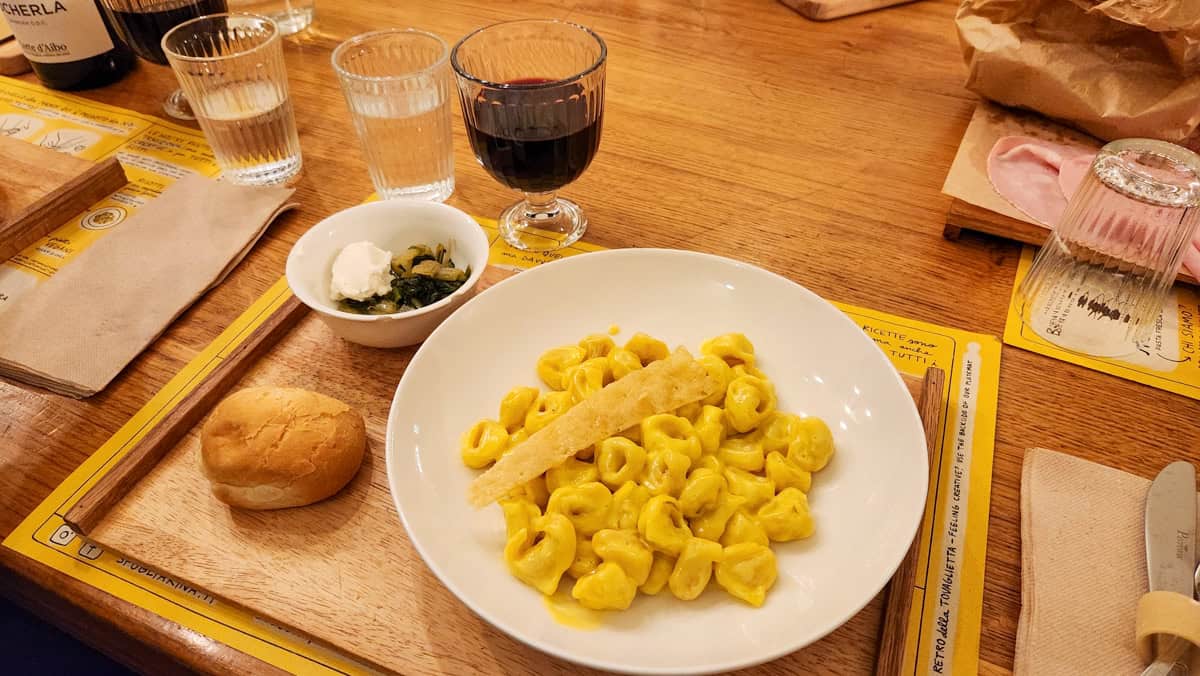
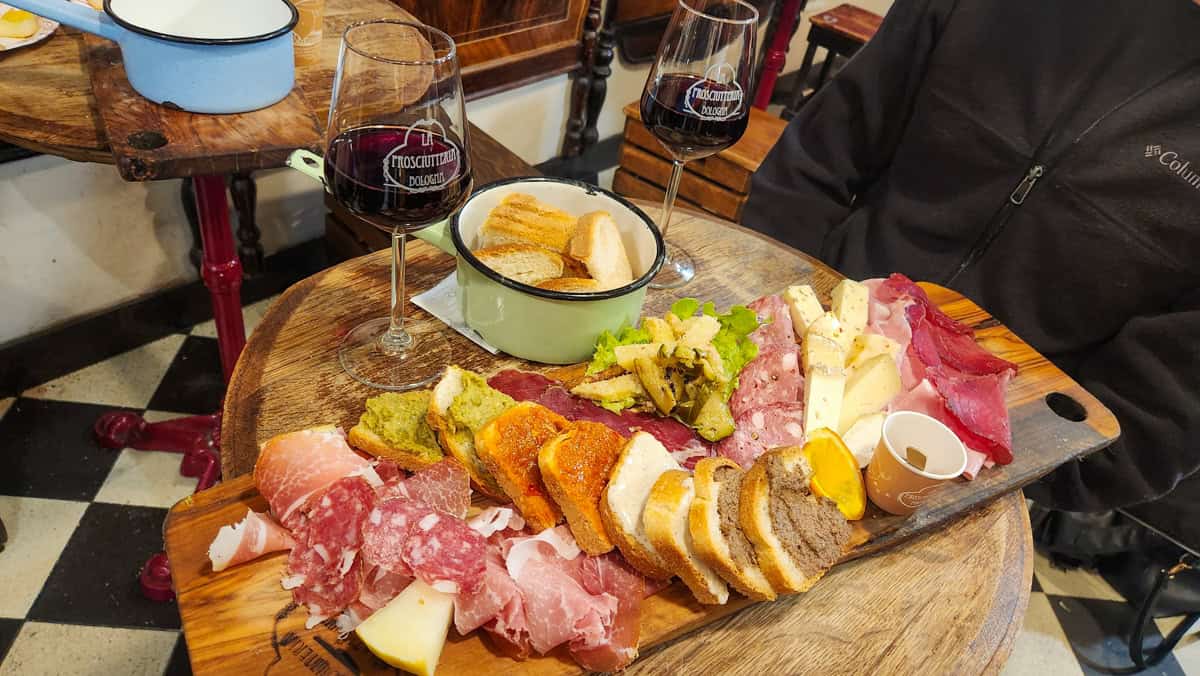
Bologna is known as La Grassa—‘The Fat One’—and for good reason: the food here is phenomenal. For lunch, the city center is packed with incredible options that showcase the best of Bologna’s culinary traditions. Here are some top picks to fuel your day of exploration.
1. Mercato di Mezzo
Located in the Quadrilatero area, Mercato di Mezzo is a lively hub of food stalls offering everything from fresh pasta to gourmet sandwiches and snacks. The market blends traditional and modern cuisine, making it a great spot for a quick bite or a leisurely lunch.
2. Tamburini
A historic deli and restaurant in the heart of the Quadrilatero, Tamburini has been serving Bologna’s best cured meats, cheeses, and fresh pasta since 1932. Their mixed charcuterie and cheese boards (taglieri) are legendary. You can also order traditional dishes like tagliatelle al ragù in the sit-down dining area.
3. Sfoglia Rina
Known for handmade fresh pasta, Sfoglia Rina is a must-visit for pasta lovers. Their menu changes daily, focusing on seasonal ingredients and Bolognese classics. Just be ready to queue up and wait in line for a bit.
4. Salumeria Simoni Laboratorio
Salumeria Simoni gourmet deli offering top-quality cured meats, cheeses, and other regional specialties. Their laboratorio features a sit-down area where you can enjoy prepared dishes or custom boards.
5. Mó Mortadella Lab
Mo Mortadella is a quirky little shop dedicated entirely to Bologna’s iconic mortadella. Known for their gourmet mortadella sandwiches, this spot is perfect for a quick, affordable, and delicious bite.
6. La Prosciutteria Bologna
Part of a small chain, La Prosciutteria serves high-quality cured meats, cheeses, and sandwiches in a laid-back, rustic setting. Everything is made to order with local products.
No matter where you go, Bologna’s city center has something for every food lover. Whether you’re grabbing a quick sandwich or settling in for a decadent charcuterie board, you’ll find the flavors unforgettable.
Pro tip: pair your meal with a glass of Lambrusco for the full Bolognese experience!
Best Bars to Visit in Bologna
Bologna isn’t just about incredible food-it’s also home to some amazing bars, offering everything from regional wines to craft cocktails.
Here are some of our favorite spots to enjoy a drink in this beautiful city:
1. Bottega Botlé
A gem for wine lovers, Bottega Botlé specializes in regional wines from Emilia-Romagna, paired with locally sourced snacks. The intimate setting makes it a perfect spot for a relaxed evening. The staff speaks English and are warm, welcoming, super knowledgeable, and happy to guide you through the wine list.
- What to Try: They have 8 local wines on tap as well as 8 Italian wines that aren’t from the region.
- Why We Love It: It’s a fantastic place to dive into the local wine culture with a side of authentic Bolognese flavors.
For more wine, we have a whole guide for our favorite wine bars in Bologna.
2. Osteria del Sole
Dating back to 1465, Osteria del Sole is one of the oldest osterias in Bologna, and it feels like stepping into a time capsule. This historic bar offers wine and beer, but no food—you’re encouraged to bring your own snacks or meal!
- What to Try: Order a glass of Sangiovese or a crisp white Pignoletto, and enjoy it alongside the snacks you brought from nearby delis.
- Why We Love It: The history and BYO-food concept make it a truly unique Bolognese experience.
3. Sette Chiese – Bistrot in Piazza a Bologna
Located in Piazza Santo Stefano, Sette Chiese is a charming bistrot known for its unbeatable outdoor seating, where you can enjoy a drink while admiring the historic square and Basilica Santuario Santo Stefano.
- What to Try: Aperitifs like Spritz or Negroni, paired with light bites (aperitivo), are a must here.
- Why We Love It: The combination of great drinks and one of Bologna’s most picturesque settings is hard to beat.
4. Astral Beers Pub
A haven for craft beer enthusiasts, Astral Beers Pub offers a rotating selection of Italian and international craft brews. The pub’s laid-back vibe makes it an ideal spot for a casual night out.
- What to Try: Sample a local IPA, stout, or sour beer from small breweries across Italy. Their knowledgeable staff can help you pick the perfect pint.
- Atmosphere: Cozy and unpretentious, with a mix of locals and visitors enjoying the growing craft beer scene in Bologna.
- Why We Love It: It’s a refreshing break from wine and a great place to explore Italy’s burgeoning craft beer industry.
5. Fior di Sale
Fior di Sale is a sleek and stylish bar specializing in artisanal cocktails, blending classic recipes with innovative twists. Fior di Sale’s attention to detail makes every drink an experience.
- What to Try: Their signature cocktails often feature local ingredients like balsamic vinegar, fresh herbs, or Lambrusco reductions. Try their modern take on an Old Fashioned or a Bolognese-inspired Negroni.
- Why We Love It: The creative cocktails and elegant setting make it a standout spot for craft cocktail lovers.
>> If you’re still thirsty, we have a whole guide just for the cocktail bars in Bologna!
What to eat in Bologna, Italy

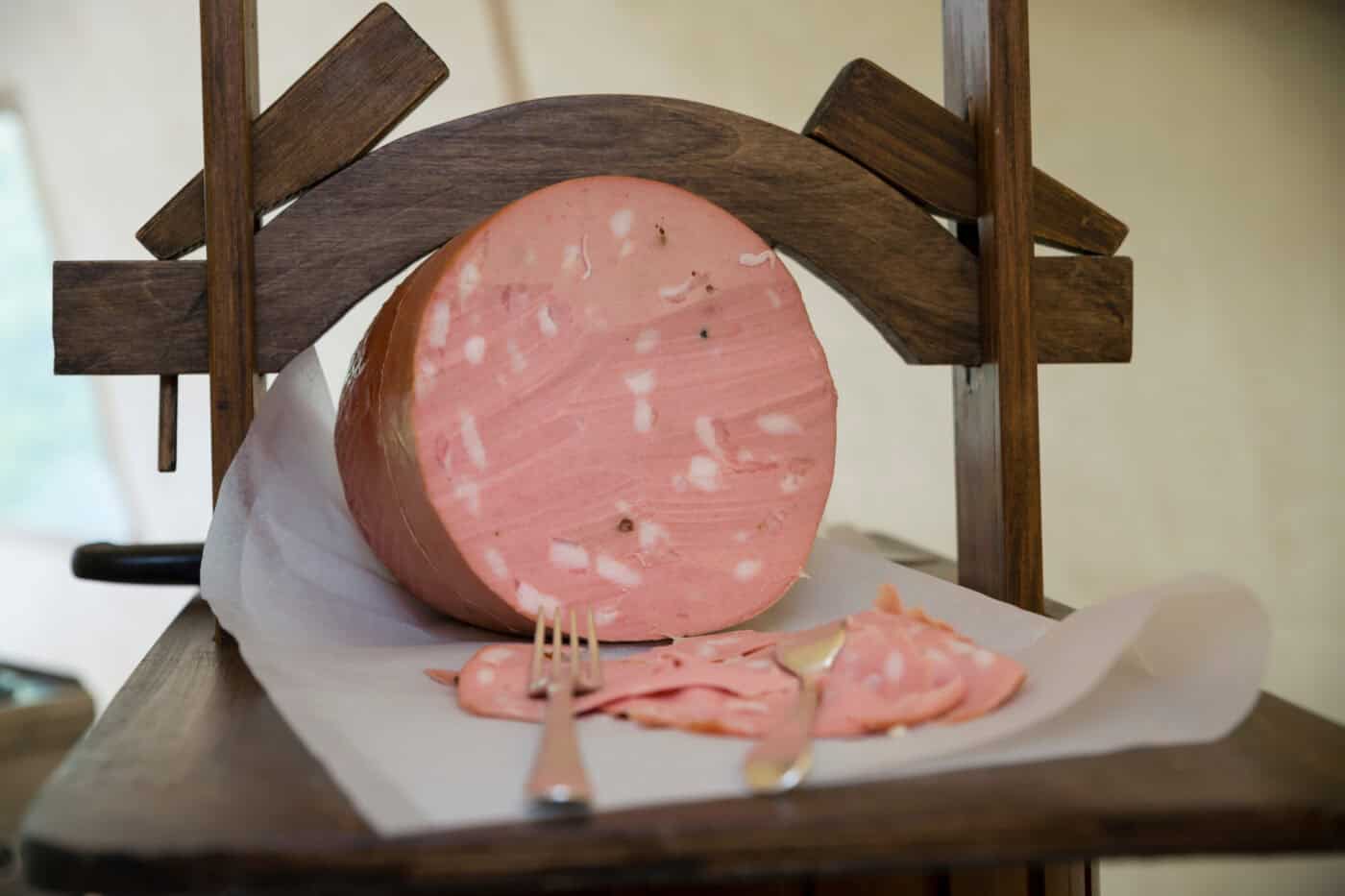
Bologna, often called the “Food Capital of Italy,” is world-famous for its rich culinary heritage. Here are some of the iconic foods Bologna is known for:
1. Tagliatelle al Ragù (Bolognese Sauce)
Long ribbons of fresh egg pasta (tagliatelle) served with a slow-cooked meat sauce. Unlike the “spaghetti Bolognese” you might find elsewhere, authentic ragù in Bologna is thicker, richer, and paired with tagliatelle rather than spaghetti. Just trust us, it’s better.
2. Tortellini in Brodo
Tiny, ring-shaped pasta stuffed with a mixture of meats and cheese, served in a flavorful meat or chicken broth.
Tortellini is said to be inspired by the shape of Venus’s navel and is a staple of Emilia-Romagna’s cuisine. It’s particularly popular during the holiday season and colder months.
3. Lasagne alla Bolognese
Layers of fresh egg pasta, rich ragù, creamy béchamel sauce, and grated Parmigiano Reggiano, baked to perfection.
Bologna claims to have invented lasagna, and their version is a hearty, luxurious take on this classic comfort food. It’s like no lasagna you’ve ever tasted before – and that’s a really good thing!
4. Mortadella
A large, smooth-textured pork sausage studded with cubes of delicious fat, seasoned with spices, and sometimes pistachios.
Known internationally as “Bologna sausage,” this delicacy originated in Bologna and is vastly superior to the American version. It’s often served thinly sliced or in sandwiches.
5. Tigelle
Small, round flatbreads made from a simple dough, grilled or baked, and often served warm. They’re filled with cured meats, cheeses, or spreads like pesto modenese (a pork fat and rosemary spread). At first glance, they may look like English muffins, but don’t be fooled.
Tigelle are a traditional snack or appetizer in Bologna and a perfect accompaniment to mortadella or salami.
6. Parmigiano Reggiano
A hard, aged cheese with a nutty, savory flavor, often grated over pasta or eaten in chunks. As one of the 5 provinces that can produce this cheese, Bologna proudly incorporates it into many dishes.
Parmigiano Reggiano is known as the “King of Cheeses” and is integral to Bolognese cuisine.
7. Prosciutto di Parma
Dry-cured ham from nearby Parma, thinly sliced and enjoyed as an antipasto or in sandwiches.
While technically from Parma, this melt-in-your-mouth prosciutto is a staple on Bolognese menus and pairs perfectly with local breads.
8. Gelato
Creamy, flavorful Italian ice cream, often found in artisanal gelaterias around the city. Bologna is home to the Carpigiani Gelato University, making it a hub for some of the best gelato in Italy.
Dinner Options in Bologna
1. Trattoria Da Me Nella Torre
Nestled in the heart of Bologna, Trattoria Da Me Nella Torre offers an authentic dining experience steeped in tradition. Known for its handmade pasta and classic Bolognese dishes, this trattoria delivers hearty, flavorful meals in a cozy, inviting atmosphere. Try their tagliatelle al ragù or their indulgent lasagna verde for a true taste of the region. Meals here typically range from €15–€30 per person.
2. Trattoria Battibecco
For a refined yet welcoming dinner, Trattoria Battibecco is an excellent choice. This elegant restaurant specializes in elevated interpretations of traditional Bolognese cuisine, featuring seasonal ingredients and a carefully curated wine list. Signature dishes include tortellini in brodo and their exquisite filet of beef with balsamic vinegar.
3. Marsalino
Marsalino offers a more casual, trendy vibe for dinner. Known for its small plates and innovative takes on classic recipes, this spot is popular with locals looking for a relaxed evening out. Pair your meal with a craft cocktail or glass of regional wine. It’s an affordable option for sampling modern Bolognese flavors.
4. All’Osteria Bottega
If you’ve looked up the best restaurants in Bologna, All’Osteria Bottega will have surely been mentioned. This small yet iconic osteria is a favorite for food purists who want an authentic, no-frills experience. They pride themselves on traditional recipes, using high-quality local ingredients to create unforgettable dishes like tortellini in brodo and cotoletta alla Bolognese. With its limited seating, reservations are a must and you’ll need to call them at least 2-3 weeks out for a weekend dinner.
Where to stay in Bologna, Italy
If you are staying beyond this one day in Bologna guide, we would recommend the following hotels below:
1. Grand Hotel Majestic
- Location: Central, near Piazza Maggiore and the iconic Two Towers.
- Features: Elegant rooms with antique and modern furnishings, and a renowned fine-dining restaurant
The Grand Hotel Majestic “già Baglioni” is the oldest hotel in Bologna. Built at the request of Cardinal Prospero Lambertini (who would later become Pope Benedict XIV), this building was first an archiepiscopal seminary. Its prime location was strategically placed at the crossroads of ancient Roman roads, and later became home to medieval mansions.
In 1911, the palazzo was transformed into a hotel, preserving its historical grandeur. Over the years, it’s been lovingly restored, especially after WWII, and reopened in 1987 under new ownership. Today, this iconic hotel is Bologna’s oldest and most luxurious so you can expect a price tag to match.
Click here to check current prices and availability.
2. Albergo Garisenda
- Location: near the Two Towers
- Features: updated rooms with essential amenities
Albergo Garisenda is centrally located, right across from Bologna’s famous Towers. Offering comfortable rooms with essential amenities like TV, free WiFi, and wood or tiled floors, it’s a great choice for a stay in the heart of the city. Being on the main street might be noisy so please keep that in mind when booking.
Click here to check current prices and availability.
3. Buon Hotel Bologna Centro
- Location: Quiet area, yet close to Bologna’s historical center
- Features: Cozy, budget-friendly accommodations, clean, simple rooms
Buon Hotel Bologna Centro offers a convenient stay just steps from Piazza Maggiore. With modern, air-conditioned rooms equipped with a LED TV, mini-fridge, and private bathroom, guests can enjoy comfort and convenience.
Click here to check current prices and availability.
Tours in Bologna Italy
Walking tours in Bologna are a fantastic way to explore the city’s rich history, stunning architecture, and hidden gems. Whether you’re discovering medieval towers, strolling through picturesque porticoes, or learning about the city’s culinary heritage, a guided tour offers fascinating insights into Bologna’s culture.
With expert guides leading the way, you’ll uncover local stories, visit iconic landmarks like Piazza Maggiore and the Two Towers, and experience the charm of this vibrant city up close. It’s the perfect way to see Bologna from a local’s perspective.
Our favorite tour brands are Viator and Get Your Guide. Below are some options for both you can browse if you want to add a tour on to your one day in Bologna.
Viator
Viator is a massive online hub for all kinds of tours and excursions. You can find tons of options, like cooking classes, walking tours, street art lessons, and more, in cities all over the world. It’s a great resource for discovering specific tours no matter where you’re headed.
Click here to see all tours in Bologna on Viator.
Get your Guide
By the end of your one day in Bologna adventure, you’ll have experienced the city’s rich history, delicious cuisine, and vibrant culture.
Whether you’re wandering through medieval streets, admiring ancient landmarks, or indulging in local delicacies, Bologna offers a memorable mix of experiences. If you’re planning a longer stay, there’s plenty more to explore, but even in just one day, this city will leave a lasting impression.
Psst! Looking for other Italy guides? We’ve got a bunch. Click here to see them all or check out the most popular below:
- The 5 Best Day Trips from Bologna, Italy
- Dozza, Italy: A Hidden Gem for Wine Lovers and History Buffs
- 2 day in Milan, Italy – The Perfect Weekend Itinerary
- Ultimate Road Trip to Tuscany: A Wine Lover’s Paradise
- The Best 3 days in Rome Itinerary Guide
- How to do Florence in 3 days – The Ultimate Florence, Italy Itinerary
Ready to visit Bologna? Read hotel reviews on TripAdvisor then book your room here!
Don’t forget to pick up a travel guidebook for your other adventures.
Love this guide? Have questions? Get in touch with us on Facebook | YouTube | Instagram | Pinterest
